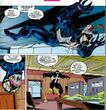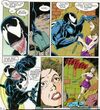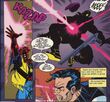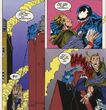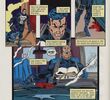Venom Overview: Lethal Protector
Seeing as how the world reels amidst a global pandemic and I’ve been sitting in my house for over four months with little human contact, I figured now is the best time to talk about Venom. The character has always been a favorite of mine, primarily due to his stellar visual design and foundational stories drawn by Todd McFarlane, Erik Larsen, and especially Mark Bagley. When I first became interested in comics, I bought anything that had Venom on the cover. I was enthralled. But, while filling in back issues, I discovered that the character starred in a flurry of 90s miniseries that are hard to organize chronologically and track down. Perhaps a low print run is guilty, but I seldom found these miniseries at conventions or in back issue bins. When I did, the sets were incomplete and generally overpriced considering the general worthlessness of 90s comics.
Luckily, Marvel published two omnibuses (with the ludicrous name that I love, “Venomnibus”) containing all of these mid-to-late 90s miniseries in order. I bought the collections a few months ago. Besides the first few miniseries, these stories are all new to me. As I write this introduction prior to reading, I predict most of them will not be of the best quality, but I don’t expect high art out of my Venom comics. My overriding concern remains entertainment as I read and review these stories,. Frankly, I just want to read a toothy, muscular lunatic rant about eating brains while the outside world descends into apocalypse. Hey, everyone has their own coping mechanisms.
I have a bad habit of beginning series and never finishing them. I’ll get back to my Mackie/Byrne Amazing Spider-Man (Vol. 2) and Latour/Rodriguez Spider-Gwen overviews one day! (Proofreading this months later, multiple women have come forward to accuse the creators of Spider-Gwen of being creeps. Maybe I’ll hold off on finishing my overview. This context does make the general incoherence of the run a bit clearer.) However, if you’re reading this first installment, that means I have already written the whole overview of over seventeen Venom miniseries. I plan on documenting my thoughts on each miniseries shortly after reading each so they will remain fresh in my mind. If the stories become too awful and I give up, the only poor sap reading this will be the government agent tasked with monitoring the suspicious contents of my laptop. Without further ado, I will begin with Venom’s first solo miniseries!
Lethal Protector proves to be a frustrating series. I’ve probably read the story three or four times since this was a rare Venom miniseries I managed to collect in its entirety early in my fandom. Even then, despite my excitement about obtaining the series, I felt relatively ambivalent about the story. The creative team of writer David Michelinie and artist Mark Bagley is a no-brainer. These creators worked well together on the main Amazing Spider-Man book at the time, even if Michelinie had begun to run out of creative steam after writing Spider-Man stories consistently since 1985. When Marvel decided to publish this Venom solo series in early 1993, the symbiote craze was reaching its peak. Lethal Protector spins out of (and perhaps precedes by a month, if my timeline is correct) Amazing Spider-Man #375, an oversized issue prominently featuring Venom. Surprisingly, the mega-crossover Maximum Carnage is in full swing only three months later (which I will discuss shortly). Considering these factors, I assume an editorial impetus was responsible for Lethal Protector more than an overwhelming desire from Michelinie and Bagley to tell this story. The miniseries likely would have happened with or without their involvement, and I suspect Michelinie, who was protective of Venom in the character’s early years, took over writing duties out of fear that another writer would butcher his co-creation.
To the credit to the talent involved, the first half of Lethal Protector serves as a highly enjoyable beginning to Venom’s elevation as a main character. At this point in his career, Mark Bagley is firing on all cylinders. No longer the new, relatively unknown artist he started as on Amazing, he was also not yet burnt out by Spider-Man and his cast. His iteration of Venom deftly represents the character’s new role as an anti-hero. While McFarlane’s Venom is a hulking beast and Larsen’s is a slobbering lunatic, Bagley brings the character’s insanity under control. Venom’s long, saliva-covered tongue still hangs from a mouth of pointed teeth, but viewers can tell a human remains under that alien weirdness, which is not always the case with Larsen’s design. Bagley’s Venom may be fearsome and powerful, but he is still believable as a hero-of-sorts. The layouts in this book are eye-catching, and the design work for locations, like an underground city, and new characters, like the Jury and Scream, proves memorable. The loose inks by Sam DeLaRosa accentuate the art’s dynamic energy. Despite Michelinie’s capable scripting on Amazing Spider-Man, Venom’s early success rested on the stellar artists who did the heavy lifting. This Venom miniseries is no exception.
In his script, Michelinie complements Bagley’s measured depiction of Venom by walking the fine line in characterization between heroic lunacy and unambiguous villainy. Eddie Brock still occasionally mentions eating brains, but his distinct moral code now matters most. As in his appearances as a “villain” in Amazing, Michelinie’s Venom alternates between self-righteous diatribes about saving innocents to inane, distasteful jokes. The opening scene of Lethal Protector reflects this dichotomy. Venom mercilessly murders a purse-snatcher and delivers an over-the-top tirade about criminals being filth until he notices the clearly horrified victim behind him. He returns her purse, pats her on the head with a toothy grin, and departs with a joke. The woman promptly runs away with tears in her eyes. The way Michelinie creates tension between Eddie’s mental instability and single-minded determination has made the character unique and compelling since his introduction. Further, the writer makes the smart decision of using Spider-Man as a voice of reason. Although suspicious of his former antagonist’s actions at first, the hero slowly warms up to his earnest efforts at heroism, providing a sympathetic character for readers hesitant about Venom as the lead and tying the miniseries to the main character’s earlier appearances in Amazing. As Venom shifts to the role of an anti-hero, Michelinie carefully stresses continuity with his past appearances, evading the dangerous possibility of abruptly turning the character into an outright hero for his solo adventures.
Along with his pointed scripting, Michelinie develops Venom’s sandbox to buttress his new role as a main character. In the first three issues, the series explores Eddie’s childhood and establishes rejection and loneliness as driving forces in his past and present. Befriending a group of societal rejects living in a secret community below San Francisco, Eddie finds a supporting cast and develops a clear motivation to protect these “innocents” who accept him after his long history of rejection. Lethal Protector also introduces the Jury, a group of armored vigilantes led by Orwell Taylor, whose son Venom killed during an escape from prison. This group’s motivation and designs are interesting, providing a band of villains uniquely positioned to bother Venom as he navigates his role as an anti-hero. Much less welcome introductions to Venom’s rogues group are the five new symbiotes. The generic, evil corporation, the Life Foundation, induces Venom to provide offspring that choose unnamed security guards as hosts. Michelinie fails to devote time to these symbiotes or even give them names (despite the woman later named Scream being featured prominently). They are easily defeated. This begins the vicious trend of writers introducing frivolous new symbiotes and birthing a forgettable and convoluted mess of characters. Carnage proved special because the idea of additional characters like Venom was a novelty. But, every time a new symbiote arrives, the threshold for interest lowers, and the overall status of symbiotes lessens. So begins the overexposure of Venom.
The mixed bag of contributions to Venom’s orbit as a solo character reflects the mixed execution of the overall miniseries. The first half is excellent in its development of Eddie’s character, exploration of the community below San Francisco, and introduction of the Jury. These issues maintain the quality of Venom’s earlier appearances in Amazing. However, an abrupt narrative and artistic shift occurs at the mid-way point when Ron Lim replaces Bagley to finish the series. To be clear, Lim is by no means a bad artist, but he can't compare to Bagley’s level of detail and energy. Lim’s characters are flatter and less dynamic, and his sense of page layout pales against predecessor’s with overabundant empty space. This was likely a rush job, which makes sense for a fill-in. Corresponding to the art shift, Michelinie’s plot unravels in this second half. Losing the street-level focus in San Francisco, Venom battles the Life Foundation and their five new symbiotes for two issues in a generic lab in the Mojave Desert, a conflict which fails to tie into Eddie’s character development or the larger plotline in any meaningful way. The overall conclusion feels rushed and half-baked. Frankly, the departure of Bagley and distraction of Michelinie is entirely understandable because Maximum Carnage, the fourteen-issue symbiote slugfest to which both contribute, begins at this point. In an odd irony, an event involving Venom elsewhere derailed this story. Symbiote popularity both made possible and foiled Venom’s first solo series, undermining the establishment of a strong foundation for the character’s later miniseries.
Despite its unfortunate latter half, Lethal Protector is overall not a bad beginning for Venom’s solo adventures. The strength of its beginning suggests further series could work. Even as the character adopts the protagonist role, Michelinie assures readers that this is still the same Venom they love from his early conflicts with Spider-Man. The tone of the series, probably the most important element for a fledgling series, hits the right notes and should provide a template for future writers. I remain optimistic that the following miniseries will take more inspiration from the good than the bad of Lethal Protector.
By Venom’s second miniseries, which begins right after Lethal Protector ends and still amid Maximum Carnage, my worst fears about Venom in a solo series are realized. After limping through the last three issues of the prior miniseries while juggling stewardship of a huge event, Michelinie cedes writing duties of his co-creation to Carl Potts, and the results are less than spectacular. Potts maintains the street-level setting in Funeral Pyre as Venom allies with the Punisher and fights gang members for three issues. The concept is not inherently flawed. Venom could work well in a gritty crime setting, and potential exists for an interesting comparison of his moral code and that of Punisher, another anti-hero.
Indeed, for an dumb, fun action book, Venom and the Punisher fighting crime makes sense. The problem arises from the fact that this is literally all the characters do for three issues straight. Nameless goon after nameless goon gets mowed down by Punisher or mauled by Venom. The gang members are poorly written to a comedic extent, rarely posing a threat to the anti-heroes. Apparently, San Franciscan gangs in the 90s consisted mainly of white guys with backwards baseball caps who brought about total anarchy in the streets at the slightest provocation. The action itself is never interesting. Venom never unleashes his symbiote in the over-the-top brutality readers expect of him. He quickly subdues Frank Castle with a few punches to the face in their inevitable battle. Punisher resorts to simply shooting gang members, which is far from visually interesting. For better or worse, these are two characters whose main appeal tends to be violence pushed to its most absurd, graphic form. The biggest problem with this story devoted entirely to action is the mind-numbing dullness of the fighting. Beyond the mediocre action, Potts devotes no space to developing Eddie’s supporting cast in San Francisco besides a child who serves as little more than a forgettable plot device. The interactions between Brock and Castle are minimal and underwhelming. Punisher calls Venom a murderer (which, of course, he is) and the relationship never really develops beyond this point.
The closest Potts comes to crafting a meaningful plot of some sort is the origin of Pyre, an orange thug with an awful hairdo and sense of style. Before his transformation into a villain, journalist Gray Russell learns of his father’s former role as a scientist for Hydra and discovers a gang has occupied the warehouse above a Hydra facility. He then makes the logical choice and joins the gang solely as a means to enter the lab. However, the thugs plan on pressuring him to murder civilians as an initiation, and he sends out a message for help. Although he receives the plea, Venom is unable to prevent Russell from gunning down civilians and transforming himself into the one-dimensional villain of Pyre with Hydra tech. Russell then attempts to kill everyone in his path out of anger that Venom was too late to prevent him from killing anyone. Try piecing that one together. Like many generic 90s villains, Pyre’s sole power is shooting energy blasts from his hands. Punisher tries to use a … sigh … counter-frequency to negate the villain’s power but ends up overloading and killing him in what Potts intends to be a tragic conclusion. Venom feels responsible for Pyre’s creation, which seems out-of-character considering how marginally involved he was with Russell. Even Spider-Man would have a hard time feeling guilty about this twerp’s descent into villainy. Perhaps this plot point would have worked better if Potts drew parallels between Russell’s fall from grace and Brock’s former role as a villain, but he does not. The series ends with the shocking cliffhanger that Pyre avoided his tragic fate. He luckily spares readers any further appearances.
Despite the terrible plot, the most concerning aspect of Funeral Pyre remains how little it actually involves Venom. This story didn’t necessarily need to involve the symbiotic antihero, nor is it a Punisher story. The thrust of the story concerns the cringe-inducing “development” (perhaps a bastardization of that term) of Pyre with Venom and Punisher punching goons as window dressing. The dialogue is painfully generic as characters often describe what is happening in front of them. Venom’s scripting in particular fails utterly to capture the unique voice that Michelinie carefully crafted for the character. Frankly, Venom could be exchanged with any antihero and this story would be unchanged. The closest Potts comes to convincing readers that he actually read a story involving Venom prior to writing this series is Eddie’s references to his past as a journalist, but even then, the writer could have easily found this in a Marvel Handbook. An utter disinterest for the main character in their own book is probably the worst case scenario for any solo series, and that is already evident in Venom’s second solo series concerns me.
While Potts’s plotting and scripting provides little with which he can work, Tom Lyle (who unfortunately passed away recently) does a serviceable job on art. His Venom reflects Bagley’s influence, as Venom’s tongue and teeth reside within a jaw that could realistically reside within a human skull. He is certainly muscular and slobbering, but readers can tell this Venom is not an alien monster. Further, Lyle’s storytelling remains clear despite Potts’s often disjointed script. (Entering his van at one point, Punisher comments on the painful position of his leg when that appendage isn’t even visible.) The solid page layouts, which usually center around an eye-catching central figure, at least makes this a painlessly quick read. Still, Lyle is likely responsible for the forgettable design of Pyre (which strikes me as odd considering his later role in designing the brilliant Scarlet Spider costume) and his gang members look wholly unconvincing. Moreover, a problem I have with Lyle’s art even beyond this series concerns the general stiffness of both his bodies and faces. Most figures look like posable action figures, and his characters have a limited range of emotions (although Potts admittedly gives him little to illustrate but angry, yelling people). I can tell Lyle spent a lot of time making his pencils as tight as possible (so tight that the shifts between three inkers are nearly imperceptible), but Lyle could have benefitted from loosening up a bit. Still, the art is overall a plus in Funeral Pyre.
Funeral Pyre serves as a potential bad omen for series to come now that Michelinie can no longer protect his creation from the mercies of other writers. Even with a solid status quo established in Lethal Protector, this is still a formative period for Venom. Funeral Pyre is largely uninterested in exploring the character and does him little service moving forward as a viable main act.


